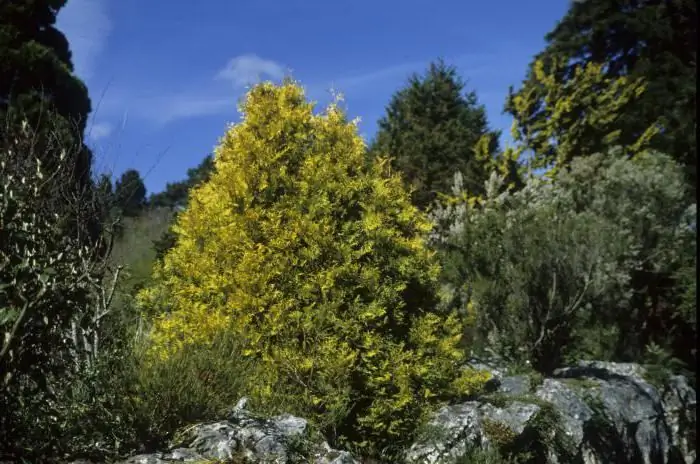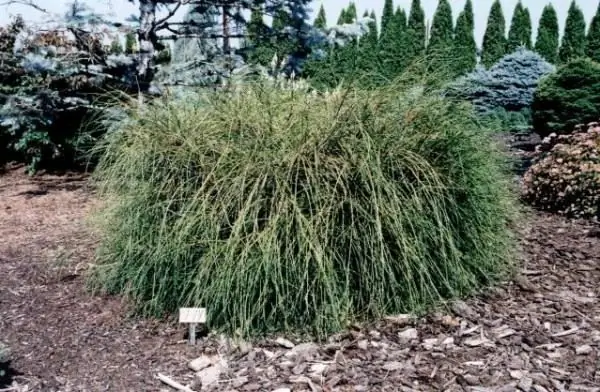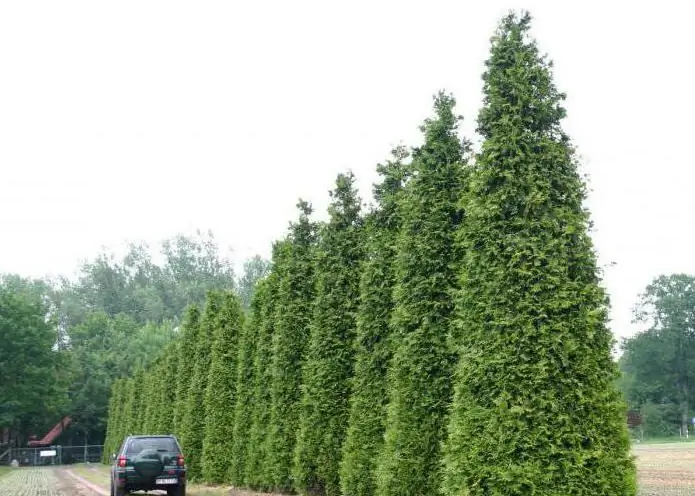Thujas have been introduced into ornamental gardening for a long time. These are evergreen and most often thermophilic representatives of the Cypress family. Slender trees and dwarf shrubs are actively used in landscaping parks, city alleys and personal garden plots. The most famous are two types: thuja folded and western. We will talk about the plant of the first type. In nature, it is distributed from the sunny coasts of California to Alaska, but in our climate it is more demanding to care for.
Botanical description

The folded thuja is sometimes also called the giant thuja, and of the informal names, the Canadian or western red cedar is especially popular. The natural habitat is quite large. It is a slender tree up to 75 cm high and with a trunk girth of up to 1.2-2.4 m. The crown shape is conical or pyramidal, the branches are located in a horizontal plane, and the shoots droop slightly. Brown-red bark 1-2.5 cm thick has many cracks. Shoots are flat, covered with glossy leaves.green outer surface and whitish underside. The tree forms large oval-oblong cones up to 12 cm long.
Place on the plot and soil
The tree is wind and shade tolerant, long-lived with a lifespan of 500 to 800 years. Thuja can develop normally both in sunny areas and in partial shade. In the first case, there is a risk that the tree will suffer from changes in day and night temperatures, dehydration will begin. Under natural conditions, thuja folded grows on wet coasts, in swampy lowlands, where it reaches truly gigantic sizes. It is not demanding on the soil, however, for better development, nutrient soil should be prepared. Experts recommend mixing sand, peat, leaf or sod land for planting in a ratio of 1:1:2.

Thuja folded: planting and caring for seedlings
There is no unequivocal opinion about the time of planting seedlings, but it should be borne in mind that during the spring planting, the plant will have time to get stronger by the cold. The size of the planting hole depends on the size of the tree, the minimum depth is 80 cm, the bottom is covered with a drainage layer (15-20 cm). When planting, leave a distance of 1-3 m between plants when forming a hedge and up to 5 m to create an alley. The root neck cannot be buried; it should be left at ground level. During the first month after planting, it is recommended to water the tree once a week, the volume of water is 10 liters, and also to carry out sprinkling (spraying) in the early morning or evening hours to avoid sunburn.
Growing thuja
Further care of the plant consists in weeding the near-stem circle from weeds, loosening it to a depth of no more than 10 cm, since the root system is close to the surface, and mulching the soil (bark, pebbles, wood chips, etc.). Thuja folded (description and photo in the text) is sensitive to a lack of moisture. With a constant lack of water, the crown begins to thin out, and the needles turn yellow. Therefore, in a dry summer, the tree needs to be watered abundantly (15-20 l) 2 times a week. If a complex mineral fertilizer was applied after planting, then the next top dressing should be carried out only after 2 years. Use, for example, the drug "Kemira Universal" at the rate of 100-120 g per 1 sq.m.
Remove dry shoots annually in the spring and trim (if necessary) to a reasonable extent. Shortening shoots to a length of more than 1/3 is not recommended. Adult plants in the Moscow climate easily survive the winter, young plants should be covered in the first 2-3 years.
Thuja folded: decorative forms

Within the framework of the natural species, it is customary to distinguish between thuja folded mountain (or eastern) and coastal. The first prefers a warm climate, and the second - continental. In decorative park culture, plants are divided into three forms depending on external features.
- Thuja plicata f. Atrovirens is one of the most showy pyramidal evergreen trees. Glossy dark green foliage is accentuated by reddish-brown wrinkled bark. Grows up to 6-7.6 m, develops slowly, lives up to 80 years.
- Thuja plicata f. Pendula (photo above) is a very spectacular thuja (folded), highly decorative form with a characteristic weeping crown. Spreading shrub, grows slowly and by the age of 10 reaches 1.8-4.5 m, shoots grow up to 30 cm per year. The branches are drooping, curved in an arc, the needles are bright green in summer and with a grayish tint in winter.
- Thuja plicata f. Fastigata - has an even columnar crown shape. The tree reaches a height of 12 m. The spread of the crown is from 2-3 m to 3-3.6 m. It is undemanding to soils, relatively winter-hardy.
One of the most decorative varieties widely used in park culture is Gelderland thuja with a cone-shaped fluffy crown. High decorativeness is achieved due to the dense needles of a rich dark green color and a bright bronze hue in winter. In 10 years, the plant reaches a height of 5 m. It is relatively frost-resistant, but in cold regions it requires shelter for the winter.

Thujas attract with their dense crown, aroma of pine needles and clear crown shapes. This is a very valuable material for landscape gardening. They are used in single and group plantings, as a living wall, to form alleys. In the garden, thuja folded (photo above) goes well with other conifers (eastern spruce, European larch), with cypress, hemlock.






